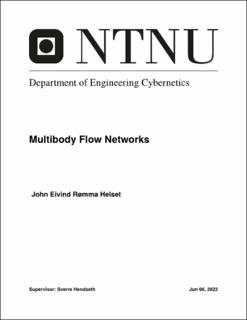| dc.contributor.advisor | Hendseth, Sverre | |
| dc.contributor.author | Helset, John Eivind Rømma | |
| dc.date.accessioned | 2022-09-27T17:21:17Z | |
| dc.date.available | 2022-09-27T17:21:17Z | |
| dc.date.issued | 2022 | |
| dc.identifier | no.ntnu:inspera:102231297:6334535 | |
| dc.identifier.uri | https://hdl.handle.net/11250/3021929 | |
| dc.description.abstract | Produksjonsplanlegging av vannkraft er understøtta av forskjellige beregninger. Mange av
beregningsmodellene legger til grunn en modell av et vassdrag. Modellene som brukes av
tunnellsystem er ofte lagd med en antagelse om at en enkelt vannkropp har tilhold i tunnellen,
samt at tunnellsystemet har en spesifikk topologisk struktur.
Kontinuerlige modeller basert på differensial-algebraiske likningssett lar derimot en
modellmaker beskrive flyt gjennom generelle tunnellnettverk, uten en del topologiske
antagelser. Det hybrid-system-teoreriske rammeverket, hybride tilstandsmaskiner, hvis
kontinuerlige dynamikk er representert av differensial-algebraiske likningssett, lar en
modellmaker direkte beskrive vilkårlige fordelinger av flere vannkropper i et
tunnellsystem. Modellen kan derfor representere mer komplekse flytmønster mellom magasinene
som er tilkobla tunnellnettverket.
En flerkropps-flyt-nettverk-modell kan settes opp på et høyt detaljnivå, og brukes til å sette
opp resten av beregningsmodellene som brukes innafor feltet. Dette er en mer effektiv måte å
sette opp modeller på, enn å sette opp hver modell isolert.
I denne rapporten blir rammeverket til den hybride tilstandsmaskinen raffinert til to nye
modelleringsrammeverk, kalt strukturerte diskret og hybride tilstandsmaskiner. Disse er
skreddersydd for konstruksjon av hybride modeller, som har et høyt diskret detaljnivå, som for
eksempel et flerkropps-flyt-nettverk. Rammeverket blir så brukt til å sette opp en diskret
modell av et flerkropps-flyt-nettverk, som kan brukes som utgangspunkt for oppsett av en
hybrid modell. | |
| dc.description.abstract | The decision making process of hydropower production planning is supported by a suite of
computations, many of which involve a watercourse model. Models of tunnel system flow used in
this context commonly assume that each tunnel system is inhabitated by a single body of water.
Furthermore that tunnel system networks conform to some fixed topology. These assumptions can,
for some computations, lead to inadequate results.
Continuous models based on differential algebraic equations enables a modeller to describe
flow through tunnel networks without the assumption of a fixed topology. The hybrid system
theoretical framework of hybrid automata, whose continuous dynamics are described in terms of
differential algebraic equations, enables a modeller to directly describe arbitrary
distributions of waterbodies in tunnel networks; to model a multibody flow network. This in
turn enables more complex patterns of flow between the reservoirs connected to a tunnel
network.
A multibody flow network model can be constructed at a high enough level of detail to serve as
a basis for tunnel system flow models in the computational models used in the context of
hydrowpower production planning. This would be a more efficient construction, than
constructing every computational model independently.
In this report the modelling framework of hybrid automata is refined into two new frameworks:
structured discrete automata, and structured hybrid automata. These frameworks are tailored to
the construction of hybrid automata, with a high level of discrete detail, such as a multibody
flow network. The framework of structured discrete automata is then used to construct a
discrete model of a multibody flow network. This model can be used as a basis for constructing
a hybrid model, in the form of a structured hybrid automaton, of a multibody flow network. | |
| dc.language | eng | |
| dc.publisher | NTNU | |
| dc.title | Multibody Flow Networks | |
| dc.type | Master thesis | |
